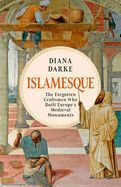
As it takes readers on a grand "architectural odyssey" through historic Italy, Spain, England, and beyond, British author Diana Dark's Islamesque: The Forgotten Craftsmen Who Built Europe's Medieval Monuments shatters long-held assumptions about the artistic pedigrees of landmark "Romanesque" buildings erected between the ninth and 11th centuries. European art historians have insisted that classical Rome was "the source of all early Christian architecture," but Darke's intellectually thrilling, evidence-based findings suggest otherwise.
Darke (Stealing from the Saracens; The Ottomans) is a cultural historian of the Middle East who has lived in Syria. Her fascination with the zigzag pattern decorating the courtyard of her Ottoman house in Damascus led her to discover the same design gracing architectural gems such as England's Durham Cathedral. The motif originated in ancient Egypt, where early hieroglyphs used a zigzag line to represent water.
Like the zigzags, features such as sophisticated geometric vaulting and carvings of fantastical creatures appear on medieval structures across Europe, and Darke asserts that only craftsmen trained in Islamic traditions were capable of such artistry. These craftsmen, whether Jewish, Christian, or Muslim, left clues to their cultural roots, including Arabic numerals carved into the roof beams of Salisbury Cathedral.
Collaboration across religious communities in the medieval era was common, Darke notes, where Islamophobia divides societies in the 21st century. She can't resist pointing out the exquisite irony that superior Islamic craftsmanship forms the foundation of Europe's majestic architectural heritage.
Darke concludes with a gallery of images, including the abbey of Mont-Saint-Michel in France and the Leaning Tower of Pisa. Islamesque is a book of wondrous discovery, complete with an elegant narrative and photography. --Shahina Piyarali

